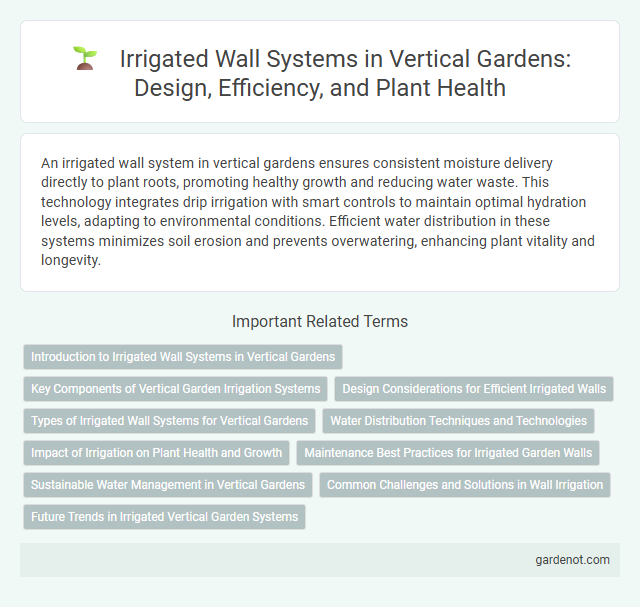An irrigated wall system in vertical gardens ensures consistent moisture delivery directly to plant roots, promoting healthy growth and reducing water waste. This technology integrates drip irrigation with smart controls to maintain optimal hydration levels, adapting to environmental conditions. Efficient water distribution in these systems minimizes soil erosion and prevents overwatering, enhancing plant vitality and longevity.
Introduction to Irrigated Wall Systems in Vertical Gardens
Irrigated wall systems in vertical gardens utilize integrated irrigation technology to ensure uniform water distribution across plant installations on vertical surfaces. These systems often incorporate automated drip irrigation or hydroponic modules designed to minimize water usage while maximizing plant health and growth. Efficient irrigation control enhances sustainability and reduces maintenance efforts in urban green walls, promoting lush vegetation in limited spaces.
Key Components of Vertical Garden Irrigation Systems
Vertical garden irrigation systems rely on key components such as drip emitters, water reservoirs, and automated timers to ensure consistent moisture delivery to plants. A network of perforated pipes or tubing distributes water evenly across the vegetated wall, optimizing plant hydration while minimizing water waste. Incorporating sensors for soil moisture and flow control enhances system efficiency by preventing overwatering and promoting healthy plant growth.
Design Considerations for Efficient Irrigated Walls
Efficient irrigated wall systems require precise integration of water distribution networks, including drip irrigation or micro-spray emitters, to ensure consistent moisture delivery across all plant zones. Selection of waterproof and breathable backing materials enhances root aeration while preventing water damage to structural elements. Designing with modular planting pockets and automated irrigation controls optimizes water use and maintains plant health in vertical garden installations.
Types of Irrigated Wall Systems for Vertical Gardens
Irrigated wall systems for vertical gardens include drip irrigation, hydroponic misting, and capillary mat systems, each designed to optimize water distribution and plant health. Drip irrigation delivers water directly to each plant's roots, reducing waste and promoting efficient absorption. Hydroponic misting systems use nutrient-rich mist to hydrate plants, while capillary mats provide consistent moisture through a wicking process, ensuring even hydration across the vertical surface.
Water Distribution Techniques and Technologies
Irrigated wall systems in vertical gardens utilize advanced drip irrigation and capillary mats to ensure uniform water distribution across plant roots, reducing water waste and promoting healthy growth. Smart sensors integrated with automated irrigation controllers optimize moisture levels by adjusting water delivery based on real-time data, enhancing efficiency and plant vitality. These technologies support sustainable water management by minimizing runoff and evaporation, making vertical gardens more viable in urban environments.
Impact of Irrigation on Plant Health and Growth
Irrigated wall systems ensure consistent moisture levels, promoting optimal photosynthesis and nutrient absorption in vertical gardens. Precise irrigation reduces water stress, preventing leaf wilting and enhancing overall plant vitality and growth rates. Efficient water delivery also minimizes fungal diseases and root rot, supporting healthier and more resilient plant development.
Maintenance Best Practices for Irrigated Garden Walls
Optimal maintenance of irrigated vertical garden walls includes regular inspection of irrigation lines to prevent clogs and leaks, ensuring consistent moisture levels for plant health. Periodic cleaning of filters and emitters promotes efficient water flow and reduces buildup that can damage the system. Monitoring plant growth and promptly addressing any pest or disease issues enhances the longevity and aesthetic appeal of the irrigated garden wall.
Sustainable Water Management in Vertical Gardens
Irrigated wall systems in vertical gardens employ drip irrigation and moisture sensors to optimize water use and reduce waste, promoting sustainable water management. These systems recycle graywater or rainwater, minimizing freshwater consumption and enhancing plant health by delivering precise hydration directly to root zones. Integration of automated controls ensures consistent irrigation, preventing overwatering and conserving resources in urban green spaces.
Common Challenges and Solutions in Wall Irrigation
Irrigated wall systems in vertical gardens often face challenges such as uneven water distribution, root rot, and water leakage, which can compromise plant health and structural integrity. Solutions include implementing drip irrigation with pressure compensating emitters, using moisture sensors for precise watering, and incorporating waterproof membranes to prevent leakage. Regular system maintenance and selecting appropriate plant species for irrigation needs also optimize performance and sustainability.
Future Trends in Irrigated Vertical Garden Systems
Future trends in irrigated vertical garden systems emphasize smart irrigation technologies integrating IoT sensors for precise water delivery, reducing waste and enhancing plant health. Advances in hydroponic and aeroponic methods optimize nutrient absorption, promoting sustainable urban greening. Emerging materials with improved water retention and durability support scalable, low-maintenance vertical gardens in diverse architectural environments.
Irrigated wall system Infographic

 gardenot.com
gardenot.com